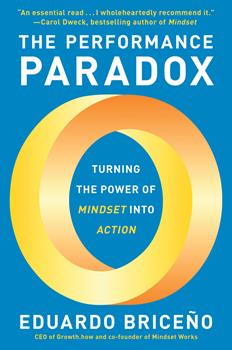The Performance PARADOX
Briceño, Eduardo. (2023). The Performance PARADOX: Turning the Power of Mindset into Action. New York: Ballantine Books
As I look back at decades of compliance, test scores, and high control over education, the results have been more dropouts and more disengaged learners. Test scores that once were used for assessing impact of teaching are now being used to judge teachers, schools, and communities. As Eduardo Briceño’s upcoming book, The Performance Paradox (2023), identifies the overfocus on performance has replaced our focus on the learning zone and how students and staff learn best.
The book is a Must-Read by The Next Big Idea Club (curated by Susan Cain, Malcolm Gladwell, Adam Grant, and Dan Pink). The hardcover, ebook, and audiobook will be released by Penguin Random House on Tuesday, September 5.
What’s the ‘Big Idea?’ While it might seem counterintuitive, constantly performing does not improve our performance. The route to success is often not a straight line. How many lessons were learned from what didn’t work. Creating a culture of learning (Eduardo calls this the learning zone) we try new ideas, get better at adding skills, and accept suggestions to improve our craft. In the learning zone we are more willing to solicit feedback from others so we can elevate our learning.
Being stuck in the performance zone, the constant attempt to get every task done as flawlessly as possible, and then some makes us less psychologically safe and the tendency is to use familiar strategies. To be a STAR (save time, add repertoire) we want to acquire more knowledge, skills, and applications.
Organizations that tread water probably will not be prepared for a new world that continues to evolve. To get better we need to break out of our chronic performance habits. Learning organizations are those that prioritize the development of people – everyone comes to work every day in part to grow and to support one another in doing so. When we replace a fixation on being right with a passion for learning, we can discover creative ways to achieve greater progress.
Briceño integrates learning theories with evidence from several businesses like Apple and Amazon. He demonstrates priorities of some of the best educational researchers like Amy Edmondson, Anders Ericsson, and Carol Dweck. As Peter Senge, MIT, said, “The only sustainable competitive advantage is an organizations’ ability to learn faster that the competition.” This will only be done in the ‘learning zone’ not only in the performance zone. Like most human systems, the answer is both/and NOT either/or.
Here are some of the ‘Learning Zone’ strategies Eduardo puts forward:
- Learning Zone Strategy # 1: Practice Deliberately
- Learning zone strategy # 2: Learn Big by Experimenting Small
- Learning Zone Strategy # 3: Work Smarter, Not Harder
- Learning Zone Strategy # 4: Create Habits to Strengthen Your “Air Sense”
- Learning Zone Strategy #5: Don’t Bulldoze
- Learning Zone Strategy # 6: Ask Why
In this book each one of the above is discussed in detail with actionable steps. It is not enough to say ‘I can learn.’ The future requires, “I know how to learn” and I want to learn. As Richard Sheridan, CEO Menlo Innovations and author of Joy, Inc. and Chief Joy Officer often says, “Run the Experiment” and “Make Mistakes Fastr.” (no, this is not a typo)
I particularly like Eduardo’s description of mistakes. “Mistakes themselves don’t lead to learning; reflecting upon mistakes does.” There are Four Kinds of Mistakes
- Sloppy Mistakes – Your heart seizes up when you see what just happened.
- Aha-Moment Mistakes – A big step in that direction was to start admitting failure, discussing it, and learning from it.
- Stretch Mistakes – If you’re never making these kinds of stretch mistakes, it means that you’re never truly challenging yourself.
- High-Stakes Mistakes – The ones you want to avoid.
The possibilities are endless when it comes to what you could test.
- Here are a few examples:
- Focus more on asking questions so the client can clarify the problem.
- Focus more on offering solutions.
- Focus more on stories.
- Approach the interaction more formally.
Mistakes are Opportunities to Step into the Learning Zone. Briceño continues by including a mistake matrix on page 91 and explains six common misconcentions about learning. This is also an important concept that learners, leaders, and organizations should be taking seriously.
I really liked the suggestion, Set Up Systems for How to Learn. Learning cultures can be the best attractor to get the best talent. Learning cultures creates places where the best learners want to be, and will help with retention. This is becoming more and more of an issue for organizations, especially in education.
Chapter 10 delves into collaboration as a superpower. Most people want to be in relationship. See Frederick Herzberg’s research. Building teams increases trust. Trust increases sharing of ideas and increases psychological safety.
There are many more useful suggestions in this book. I whole-heartedly endorse buying it, reading it, and putting these ideas into action.

